It’s no secret that Munich is one of Germany’s most expensive cities, but that doesn’t mean you can’t travel here on a budget! Here are 20+ FREE things to do in Munich that actually rock.
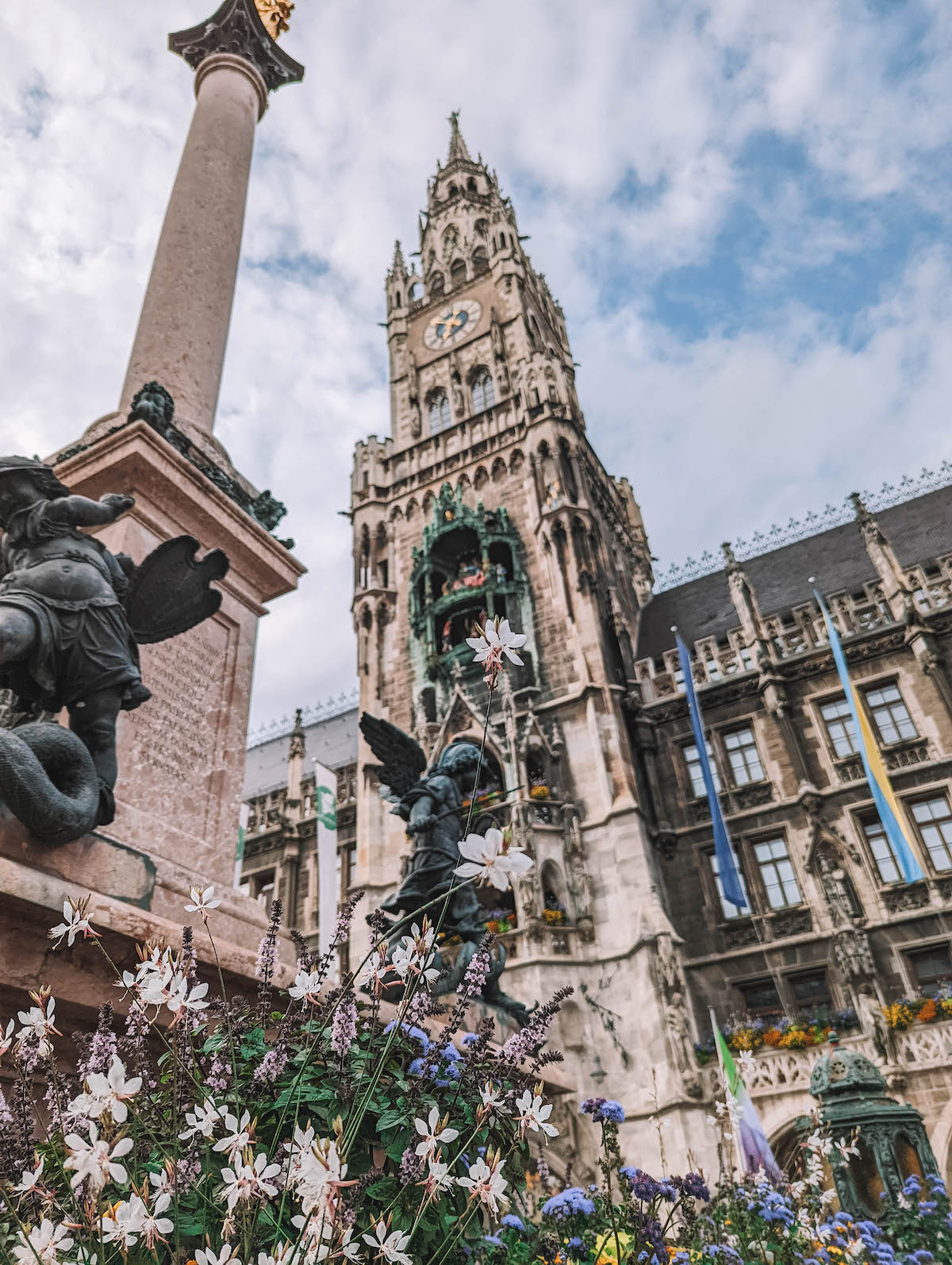
Munich is a gorgeous city in southern Germany with a rich history, stunning architecture, and a unique culture. As the capital of Bavaria, Munich is one of the top tourist destinations in all of Germany — and it’s also the most expensive city in Germany to live in, to boot!
If you think visiting Munich on a budget is impossible, think again! Whether you’re a local who’s trying to save some cash for other adventures or a first-time visitor who doesn’t want to pay out the nose for attractions, this list of free things in Munich is for you.
There are SO many free things to do in Munich, and if you know where to go you won’t feel like you’re missing out whatsoever on the city’s paid attractions.
Table of Contents
Click “show” to see the full table of contents for this post. You can jump around the post as desired by clicking on the individual sections listed below.
Visit One of the Free Museums in Munich

Munich might not have the most extensive roster of museums with free entry, but the ones that don’t charge anything are top notch! The free museums in Munich you should know about include:
- Archiv Geiger
- Paleontological Museum
- Geological Museum
- Museum of Casts of Classical Sculptures
- Bavarian State Library (The library offers rotating exhibitions, which are free to enter)
Another way to get super cheap entry into Munich’s most popular museums is to visit on Sundays. As part of the Museum Sunday program, many of the top museums charge just 1 Euro every Sunday.
Definitely double check to see if the museum you’re interested in visiting participates in Museum Sunday before you visit. My top recommendations for museums with 1 Euro entry on Sundays are:
- Pinakothek Museums (the Alte Pinakothek is shown in the photo above)
- Museum Brandhorst
- The Schack Gallery
- Bavarian National Museum
- Glyptotek
- State Museum of Egyptian Art
- The State Coin Collection
Take a Free Walking Tour
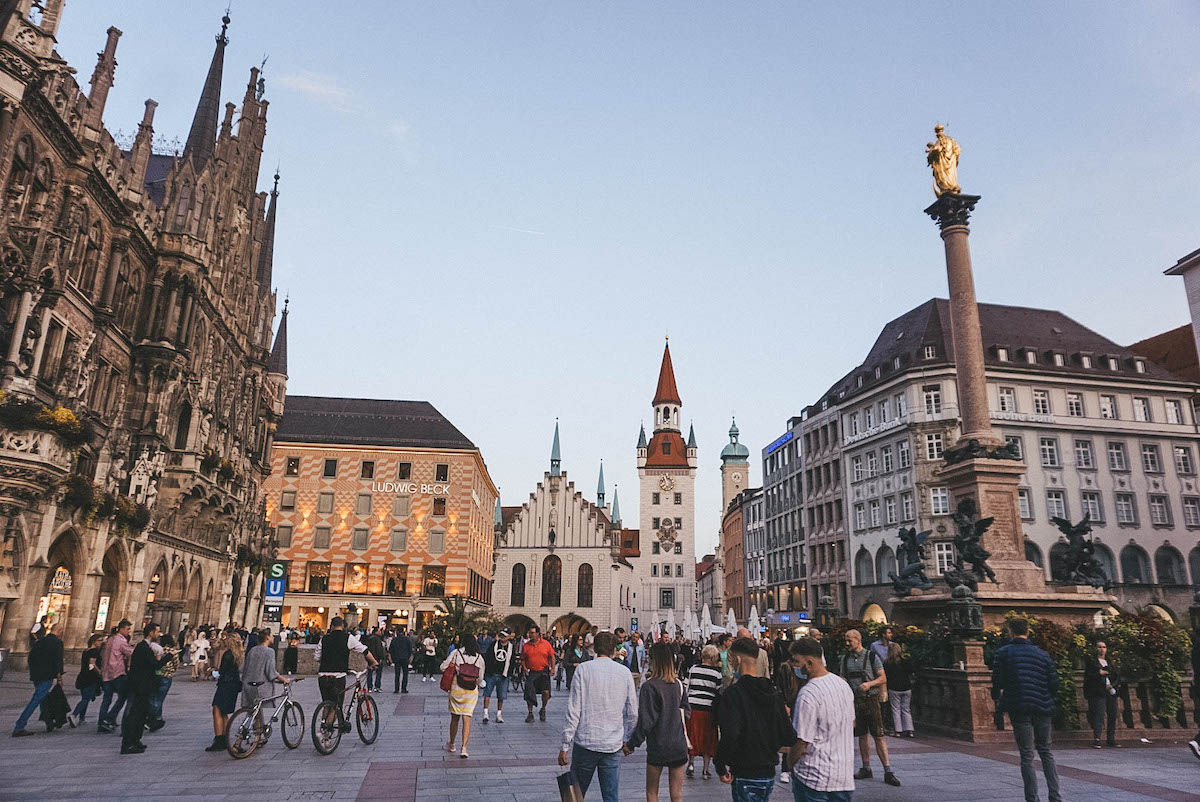
The Munich free walking tour offered through Sandeman’s New Europe is seriously good. It’s a 2.5-hour tour that will take you to the main sights in the Old Town, including the soaring Frauenkirche (church), the Glockenspiel at Marienplatz, and the Royal Residence.
If you don’t plan on touring any of the historic sites in the Old Town (like the Residence, for instance), this free walking tour will be the best way for you to hear about the city’s founding, the exploits of the royal family, and the critical role the city of Munich played in Adolf Hitler’s rise to power.
Tip: Even if you take a free walking tour, you should still tip your tour guide!
See the Residence’s Courtyards
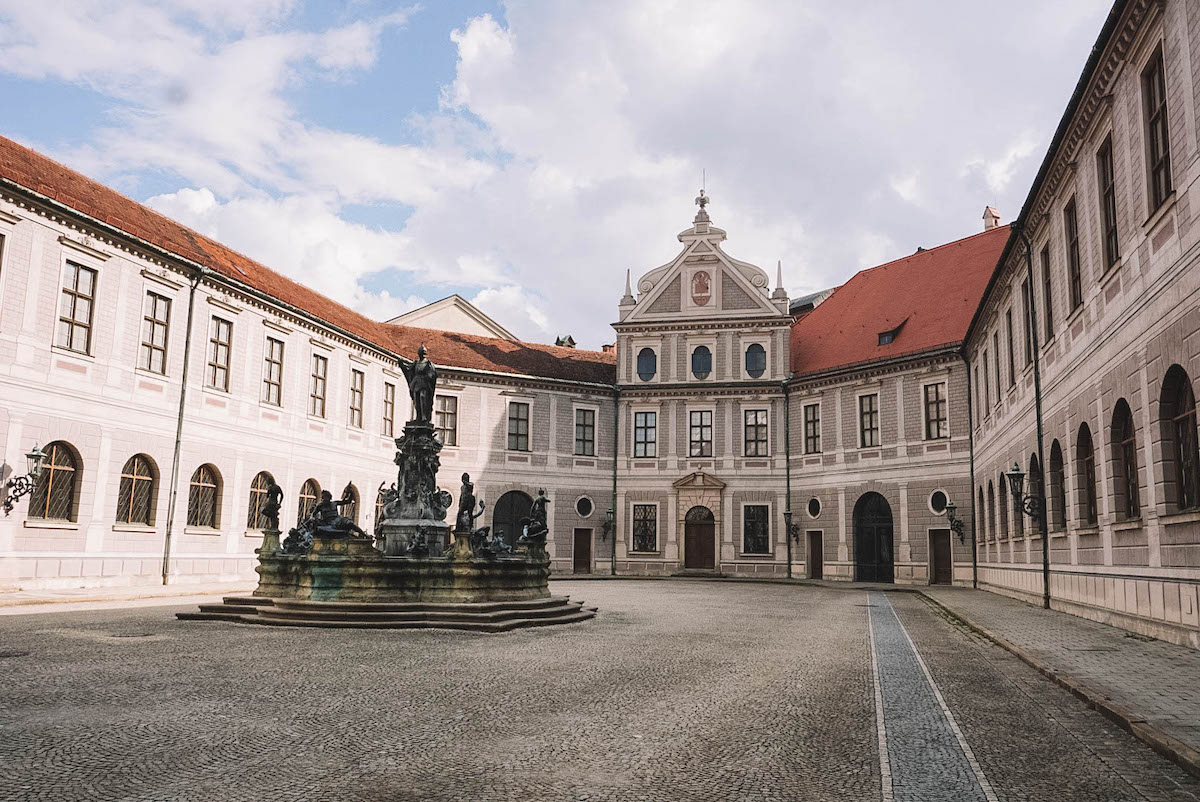
The inner courtyards of the Royal Residence are one of the free things to see in Munich that you absolutely shouldn’t miss.
Munich’s Residence was the seat of government and home of the Bavarian royal family from 1508 to 1918. The building complex you see today is massive (if you pay the 9 Euros to tour the Residence, you’ll get to see around 100 rooms — a mere fraction of what’s inside!). However, the Residence didn’t start out this big!
Over the years, each new Bavarian monarch added a wing or series of rooms to the Residence. That’s how the palace complex wound up with 10 lovely courtyards.
The courtyards of the Munich Residence are highly underrated, as they can be visited without a palace ticket. Some of the courtyards you have to visit include:
- Fountain Courtyard (Brunnenhof) — An octagonal courtyard with a fountain in the center with the likeness of Duke Otto I on top. This courtyard makes for an especially good photo op!
- Imperial Courtyard (Kaiserhof) — Built in the early 1600s. In December, one of Munich’s many Christmas markets can be found here.
- Comité Courtyard (Comitéhof) — A beautiful courtyard covered by a glass roof that leads into the stunning Cuvilliés Theater.
Stroll Through the Hofgarten
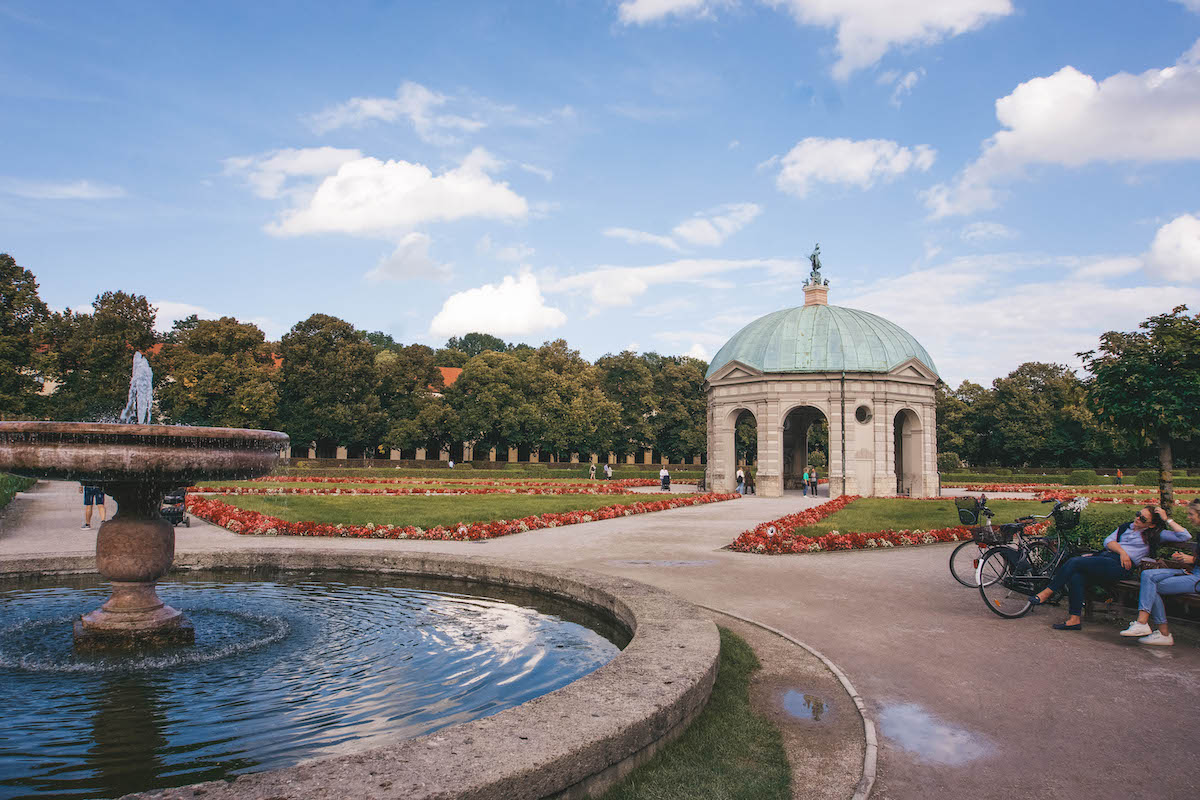
Formerly part of the Residence, the Hofgarten (“Court Garden”) was built in the style of Italian Renaissance gardens. Take a turn around the garden to fully appreciate the beautiful landscaping that so entranced the nobility when it was designed in the 17th century.
See What’s for Sale at the Viktualienmarkt
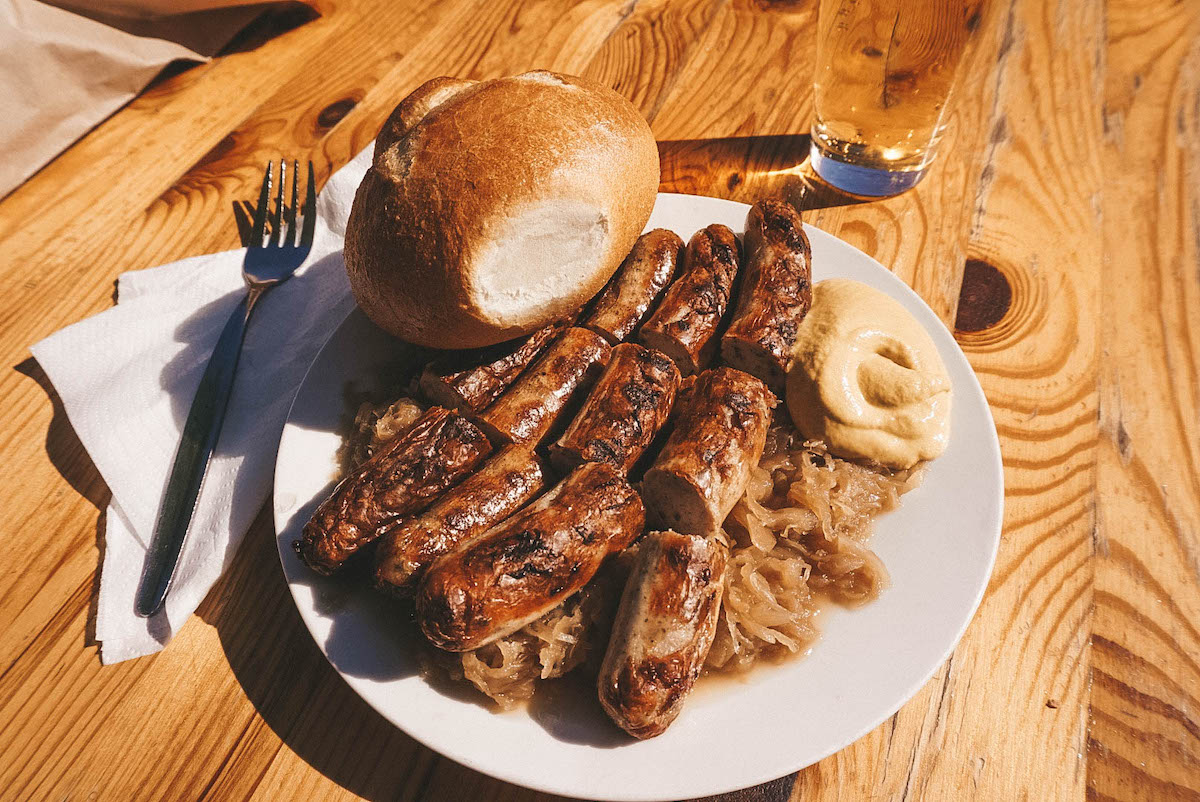
Munich’s Victuals Market began as a small farmers market in the 1700s and has since expanded to become the city’s main market. The Viktualienmarkt is one of my personal favorite free things to see in Munich; the abundance of fresh produce, cut flowers, handmade gifts, and locally produced honey is a feast for the eyes!
Entrance to the market costs nothing, but if you’re traveling on a budget this is the best place to come for a cheap, hearty, and delicious meal. You can easily throw together a quick lunch for less than 10 Euros. You’ve got your pick of fresh fruits and veggies, pre-made soups, grilled bratwurst, and more!
Tip: The Viktualienmarkt is open every day but Sunday.
Listen to the Glockenspiel at Marienplatz
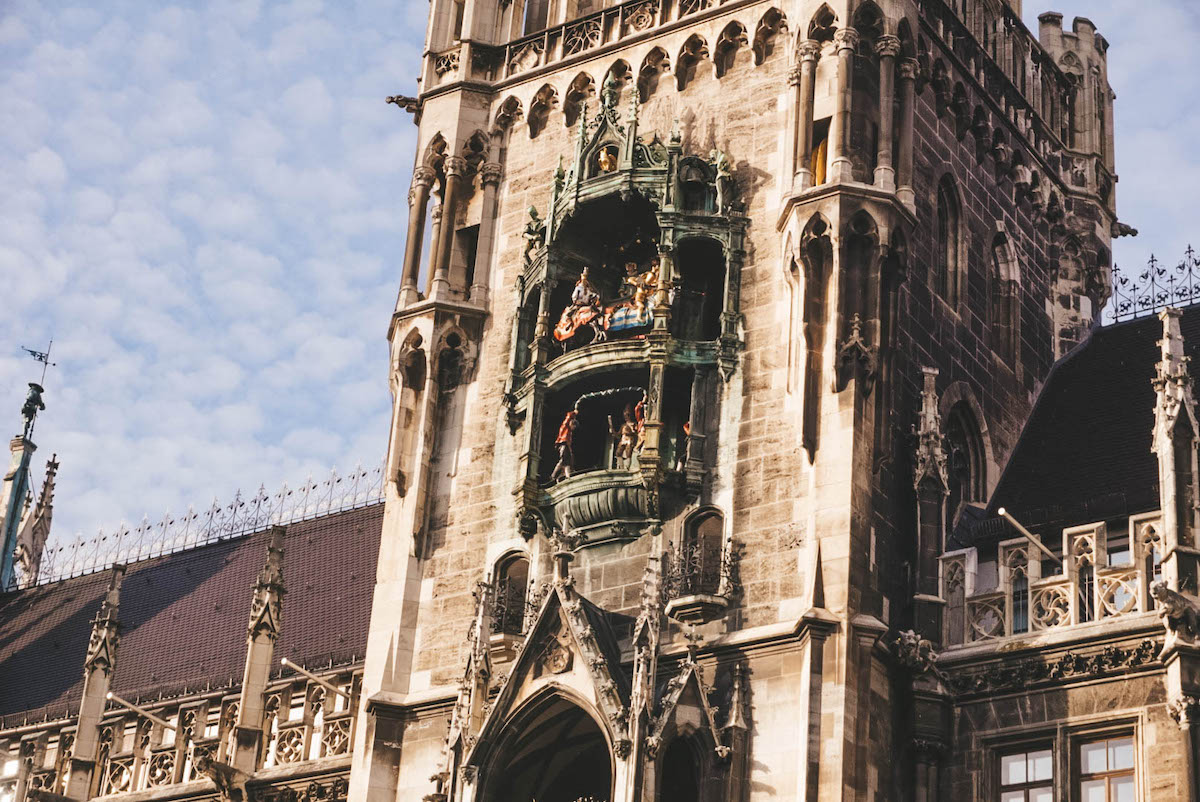
The famous Glockenspiel of the Neues Rathaus (New City Hall) plays a 15-minute song each day at 11am, noon, and 5pm (in the summer).
While the bells chime their merry tune, the figures underneath the clock spring to life! They tell the story of a jousting tournament held in the 1560s as part of the wedding celebrations for Bavarian Duke Wilhelm V and Renata of Lorraine.
Additional figures below the jousting tournament show the dance of the coopers, which they performed to celebrate the end of the plague in 1517. I’d certainly have danced to that, too!
Visit the Churches in the Old Town
Unlike the rest of Germany, the city of Munich never converted from Catholicism to Protestantism following the Reformation in the 16th Century. As such, there are a number of beautiful Catholic churches in Munich’s Old Town that you can visit free of charge.
Frauenkirche (Cathedral of Our Lady)
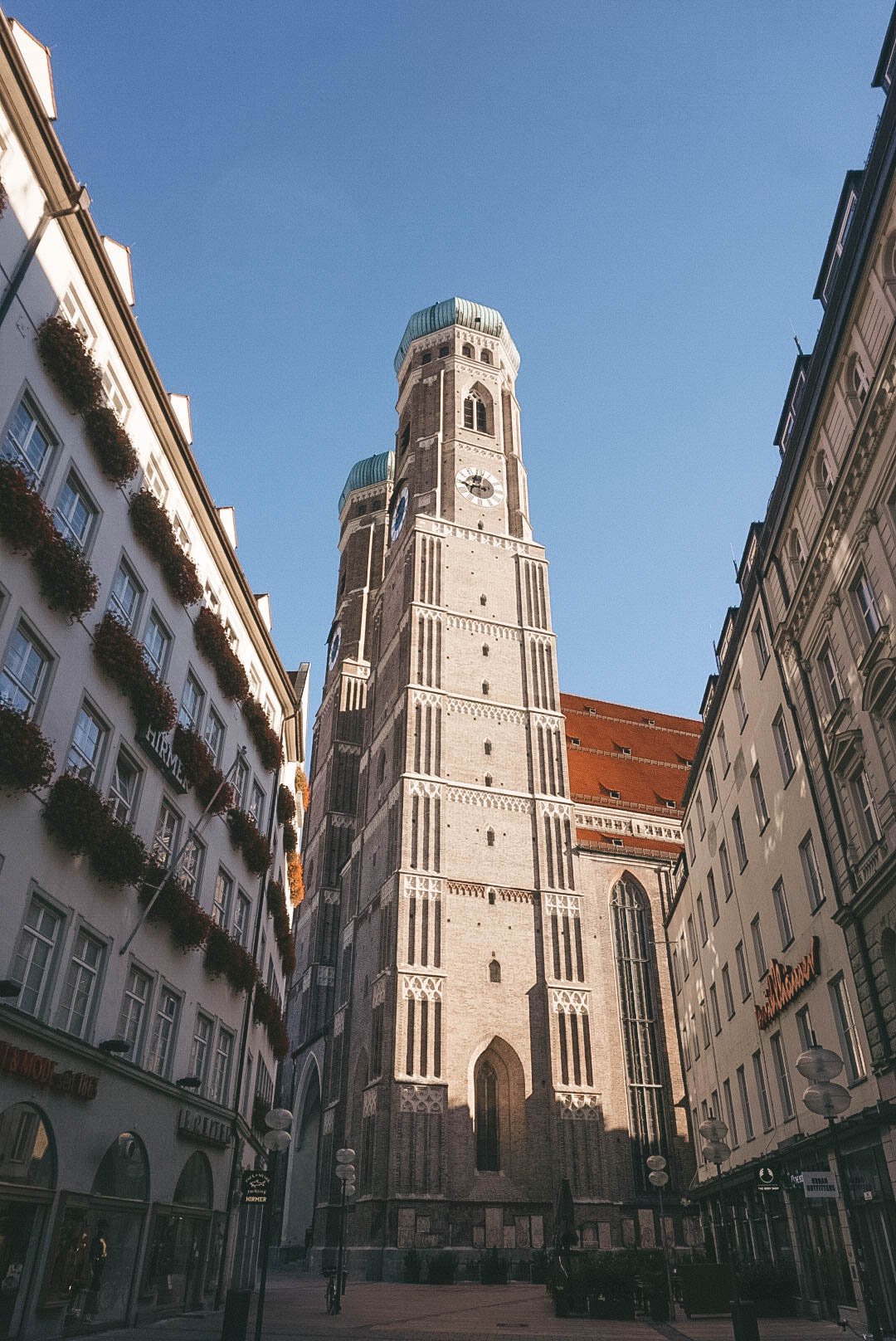
The 325-feet tall towers of the Frauenkirche were intended as a symbol of the city’s faith and the power of the Catholic church. When entering the sizeable cathedral, you might be surprised to learn that it was built in a mere 20 years.
Legend has it that the architect made a deal with the devil in order to complete the project in such a short amount of time. The devil said he’d help fund the building project — if no windows were added to the cathedral, that is.
Luckily for all of us, the architect tricked the devil and secretly added windows to the cathedral. When the devil realized he’d been tricked, he stomped his foot on the floor in anger. To this day, you can still see the “Devil’s footprint” at the entrance of the Frauenkirche.
If the Devil’s footprint isn’t one of the coolest free things to see in Munich, then I don’t know what is!
Alter Peterskirche (St. Peter’s Church)
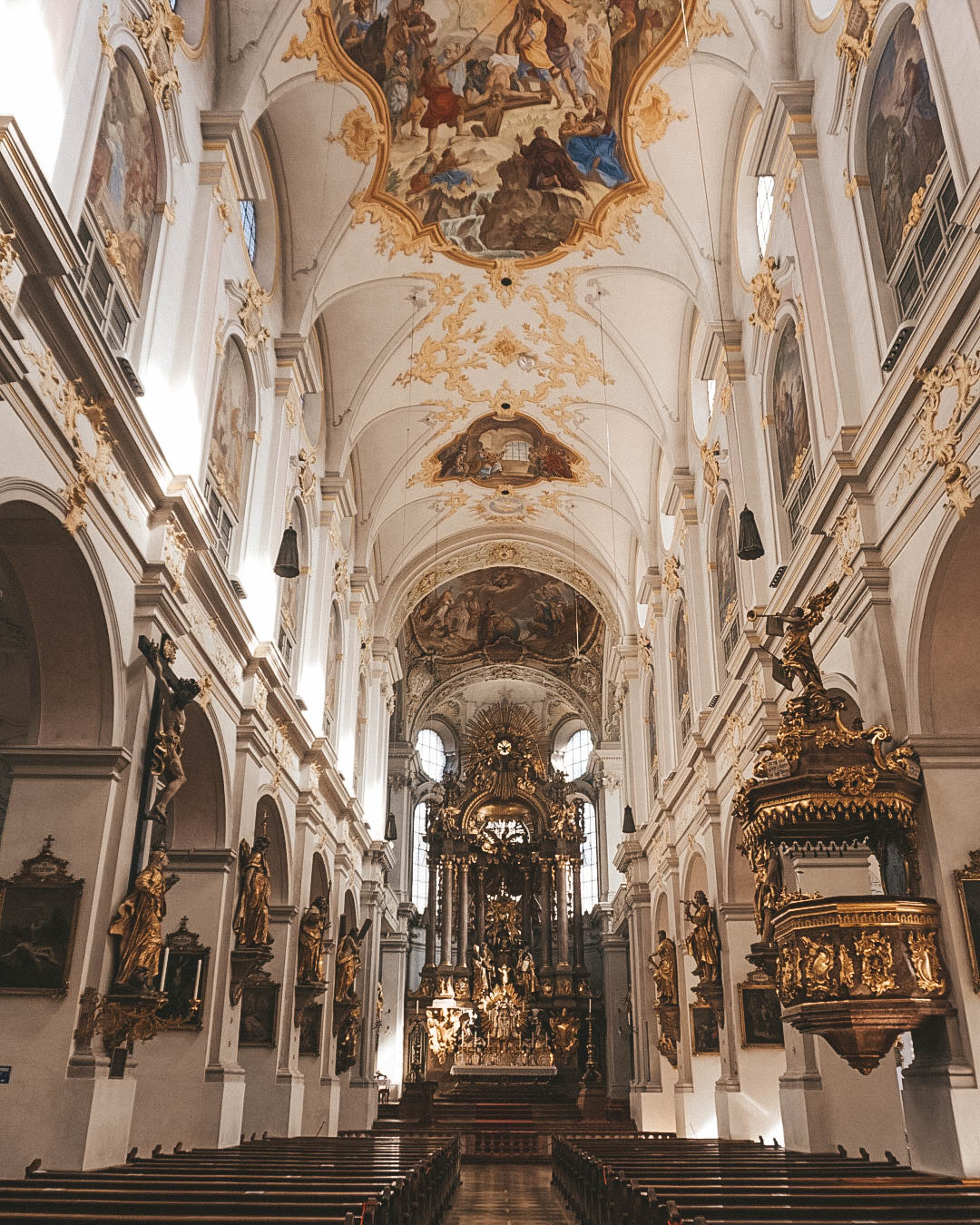
St. Peter’s is a stunning church that houses the remains of Saint Munditia, the patron saint of single and unmarried women. The bell tower with its epic bird’s-eye view of Munich is a popular tourist attraction, but the church itself is free to enter and is well worth visiting!
Asamkirche
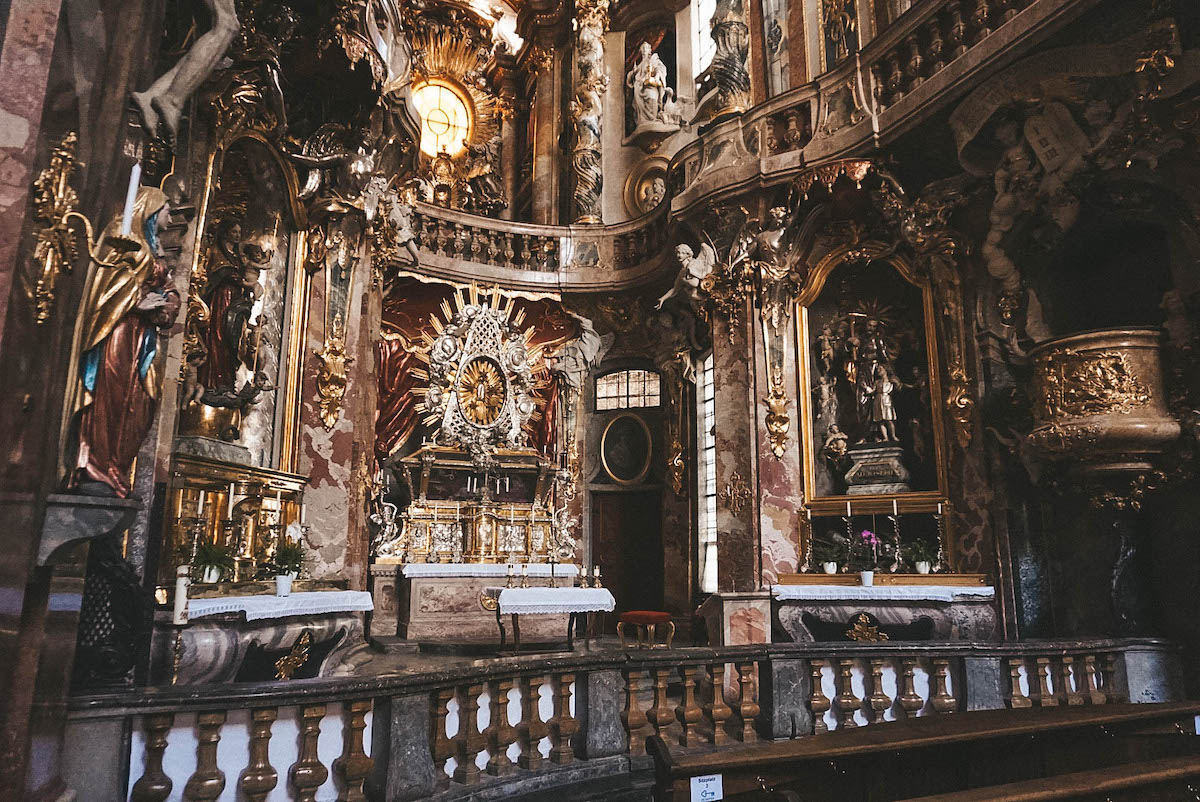
The Saint Johann Nepomuk Church is most commonly referred to as the “Asamkirche” because it was built by the Asam brothers in the 1740s.The church is just 30 feet wide but is one of the most opulent Baroque churches you’ll ever see.
Why such extravagance? The Asam brothers built the church as a showroom church to advertise their skills. They actually lived next door to the church and could see the high altar from their bedroom windows!
Theatinerkirche (Theatine Church)
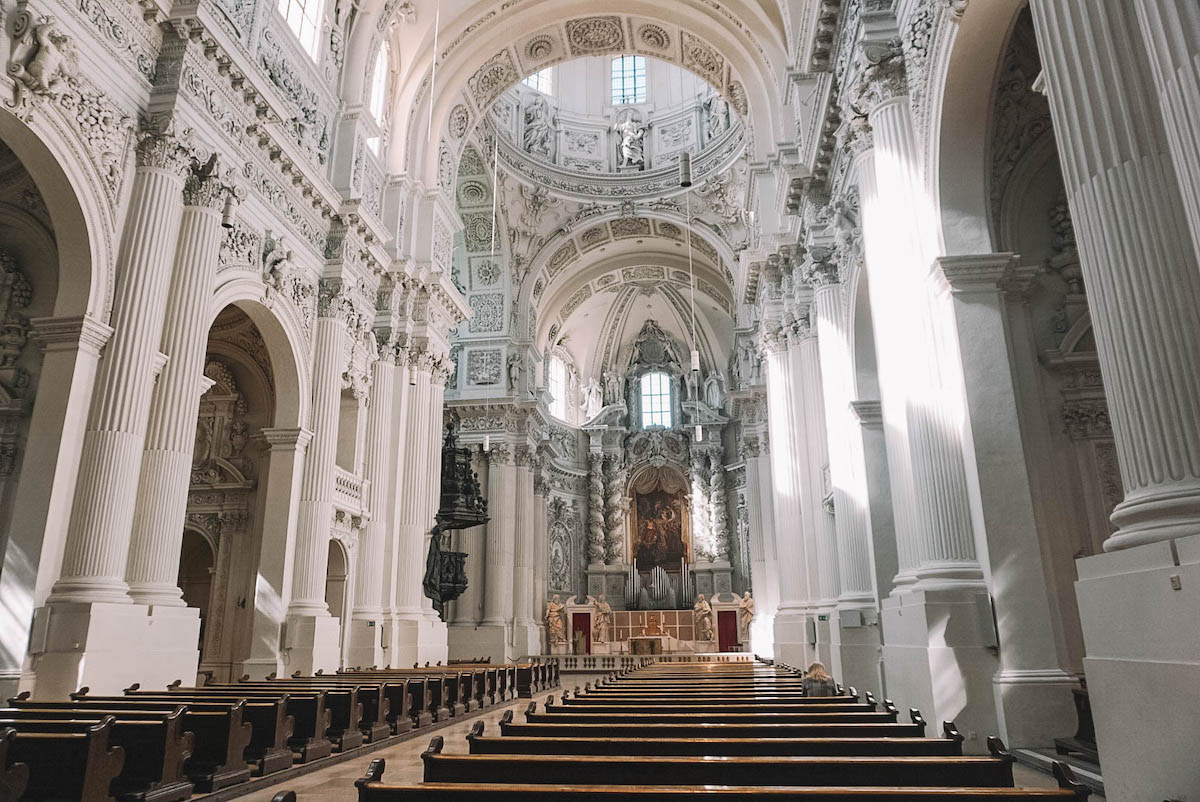
The bright mustard facade of the Theatinerkirche captures the eye as soon as you enter bustling Odeonsplatz.
The church was built by Elector Ferdinand; he and his wife spent 10 years trying to produce a male heir, and in his despair he promised to build a church in honor of Saint Cajetan of Theatine if the saint blessed them with a child.
Spoiler: the long-awaited male heir was finally born and the Theatinerkirche was built! The interior is a gorgeous example of the Italian high-Baroque style, while the facade is in the Rococo style.
Michaelskirche (St. Michael’s Church)
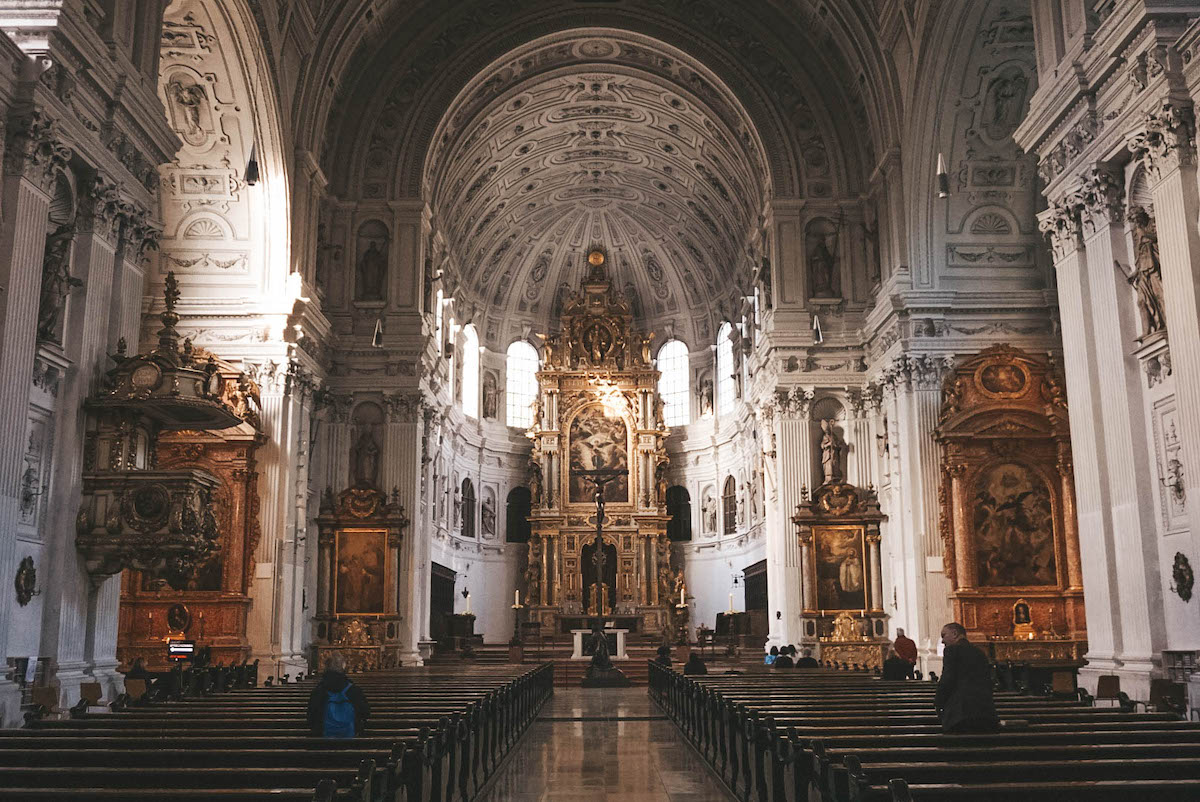
The largest Renaissance church north of the Alps, St. Michael’s was damaged in WWII and consequently is missing a lot of its elaborate stucco work. It’s still one of the most beautiful churches in Munich though, in my opinion!
While in St. Michael’s, be sure to visit the royal crypt where “Mad” King Ludwig II rests alongside nearly 40 other Wittelsbach royals.
Visit Dallmayr Delikatessenhaus
Dallmayr is one of the oldest coffee companies in Germany. It was founded in 1700 in Munich (although the name “Dallmayr” wasn’t adopted until 1870).
You’ll find Dallmayr coffee in cafes and grocery stores throughout the country, but while you’re in Munich I highly recommend visiting Dallmayr’s Delicatessen. It’s a gourmet grocery store with all kinds of produce and goods for sale, including, of course, a range of Dallmayr’s beloved coffee.
Obviously, if you’re looking for a free activity in Munich you won’t want to purchase anything at the Dallmayr Delicatessen, but since this is such an iconic Munich brand I still recommend popping in and taking a look around. (But if you need an affordable souvenir from your time in Munich, go ahead buy a bag of Dallmayr coffee beans!)
Walk Down Ludwigstraße
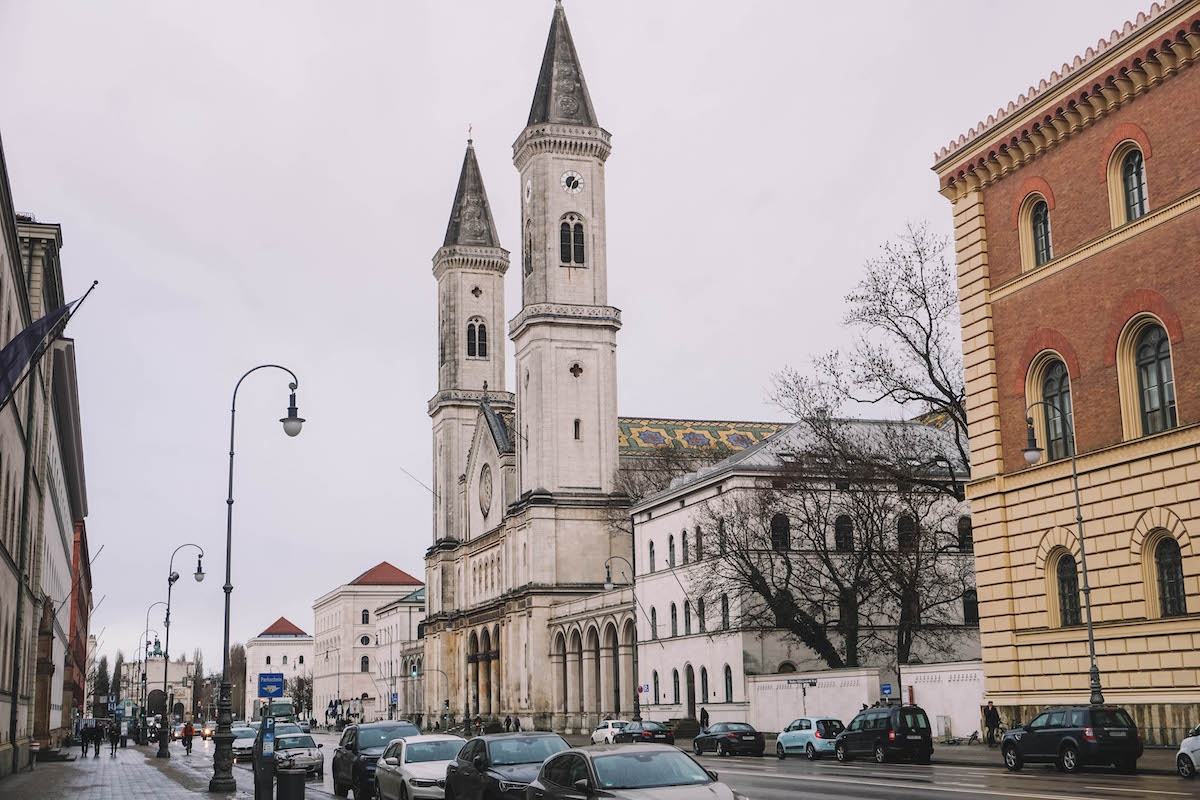
Named after King Ludwig I, Ludwigstraße is one of Munich’s four royal avenues. It was designed by Friedrich von Gärtner and Leo von Klenze in the round arch style. The buildings here are absolutely stunning, and it really feels like you’re walking down a boulevard in Rome.
I like to start my walk down Ludwigstraße at Odeonsplatz (where the Theatinerkirche is located, another free place to see in Munich!) and then work my way north to the Siegestor (gate).
Along the way, you’ll pass by the:
- Bavarian State Library — Which has a rotating free exhibit space that’s worth visiting!)
- Ludwigskirche (shown above) — A beautiful church that boasts the second-largest altar fresco in the world, after Michelangelo’s “Last Judgment” inside the Sistine Chapel.
- Ludwig Maximilian University — Look for the Geschwister-Scholl-Platz, which is dedicated to the siblings Hans and Sophie Scholl. They ran a resistance group called the White Rose, which protested against the Nazi regime)
- Siegestor (Victory Gate) —A 24-meter-high triumphal arch, topped by a statue of Bavaria. Look for the inscription “Dedicated to Victory — Destroyed by War — Urging Peace.”
This is one of my favorite walks in Munich! I love looking at the architecture and taking photos of all the little details. It’s truly one of the most beautiful streets in all of Munich!
Visit the NS Dokumentationszentrum
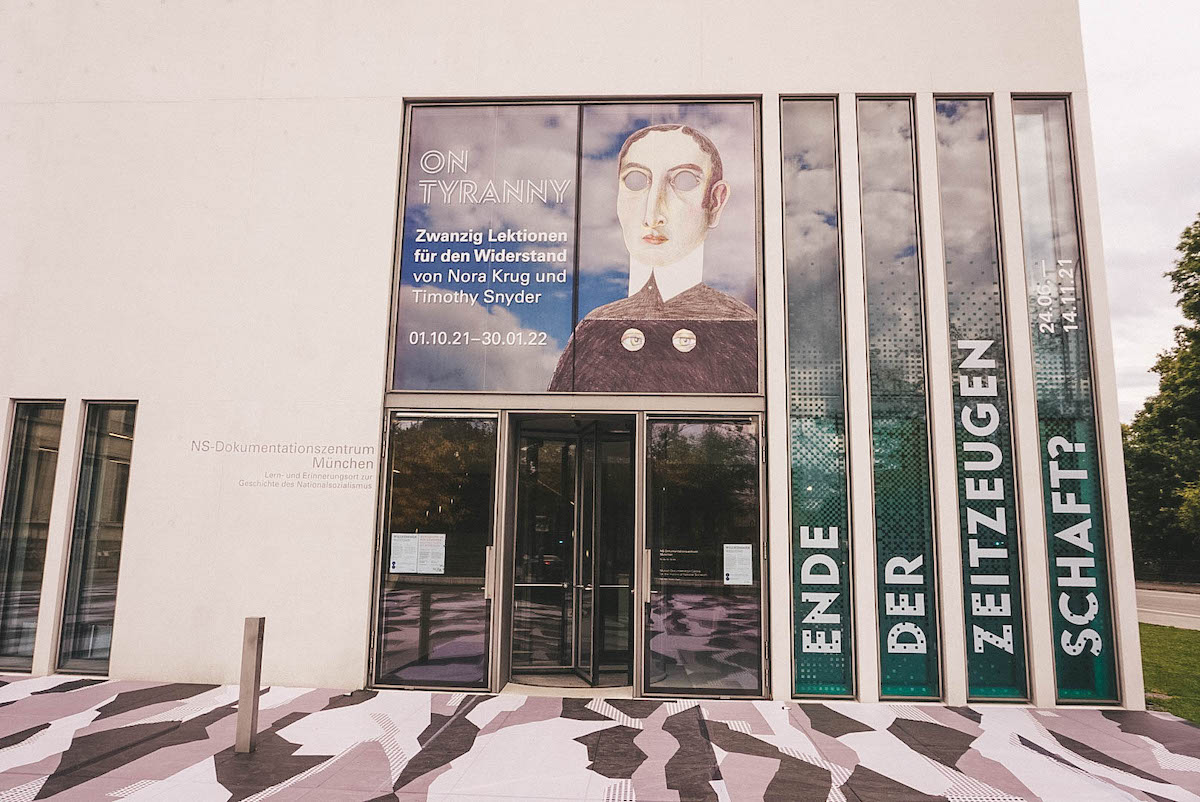
If you’ve ever wondered how Hitler came to power, the Documentation Center for the History of National Socialism will certainly clear things up for you.
Many first-time visitors to Munich don’t realize that this was where the Nazi party was founded. As such, it’s the ideal place to educate yourself on the Nazi party and the horrors that were inflicted under Hitler’s regime.
Note that this museum doesn’t display actual artifacts from the National Socialist era. Instead it presents detailed information on the Nazi party’s rise and fall via accompanying videos and photos. If you’re unfamiliar with the history of WWII (specifically from the German perspective), definitely spend a couple hours here as it’s one of the best free things to do in Munich.
Nymphenburg Palace Gardens
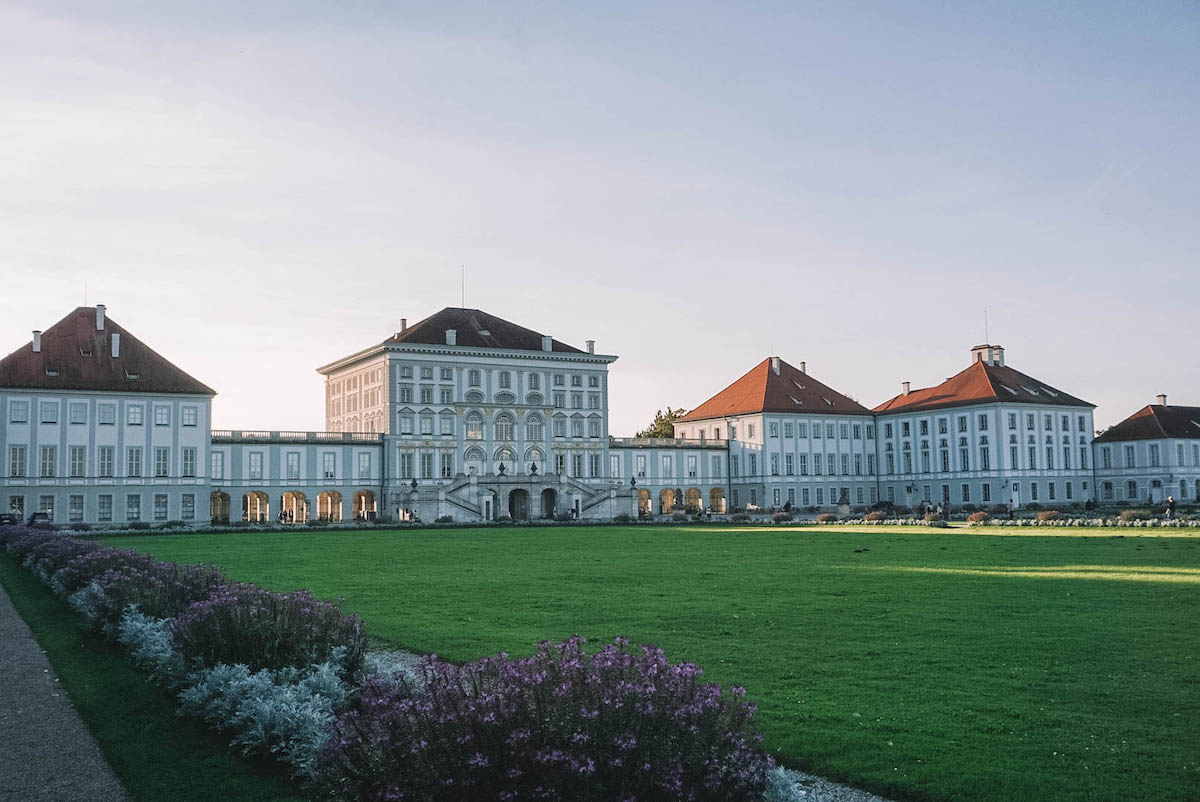
Nymphenburg Palace is a stunning Italianate-style palace located roughly 30 minutes from the city center. It was built in the 1660s as a summer residence for Elector Ferdinand Maria and his wife, Henriette Adelaide of Savoy (and boy, did they know how to do a place up in style!).
If I had to pick an all-time favorite free attraction in Munich, it would have to be the Baroque-style gardens and extensive parkland that extend behind the palace. You can enter the gardens without a palace ticket and stay however long you want.
While you’re there, make sure to visit the village with the old pump house, the historic green houses, and the great cascade. The park is packed with real and faux historic sites, statues, and fountains — you can tell this was once a playground for nobility!
Tour the Dachau Concentration Camp Memorial Site
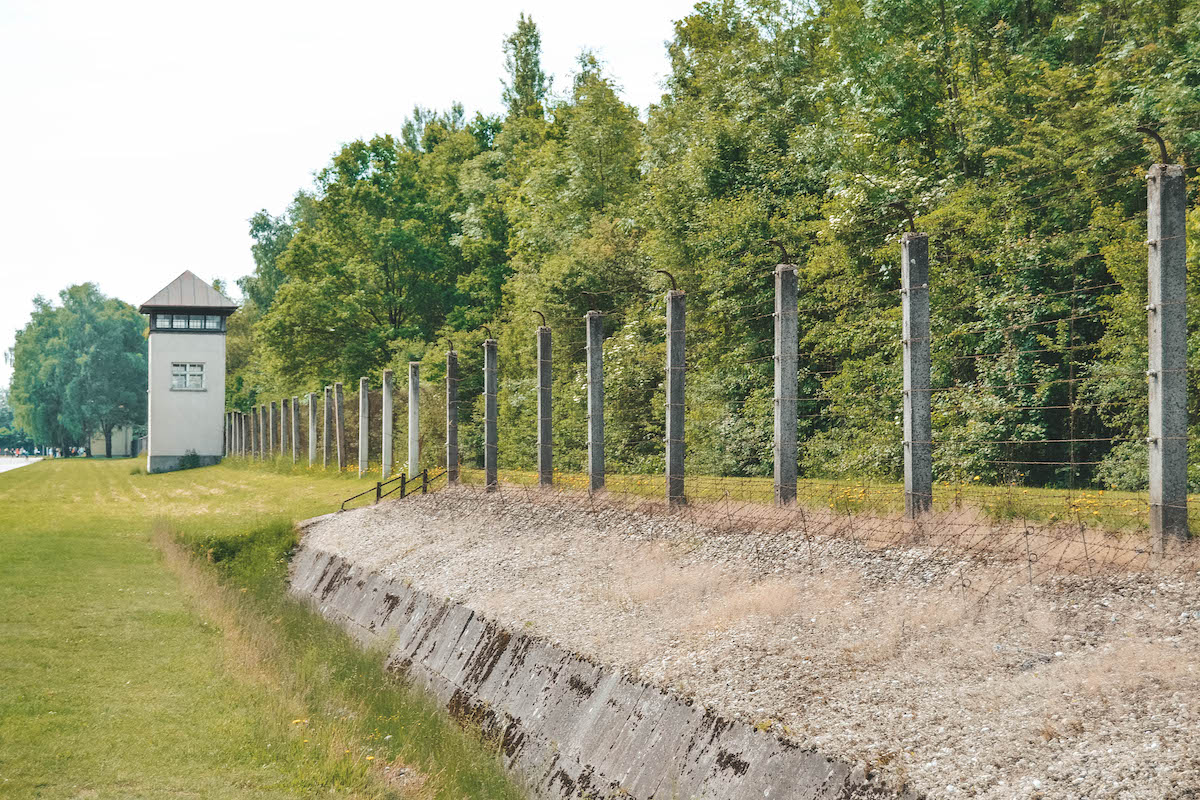
Dachau served as the first ever Nazi concentration camp and was the model for all others built during WWII. Today, the site has been largely preserved and turned into the Dachau Memorial Site.
Many of the original camp buildings still stand, and you can visit them free of charge. Some of the buildings house exhibitions detailing the camp’s history and the personal histories of some of its victims.
Enjoy the View from the Olympiaberg (Olympic Hill)
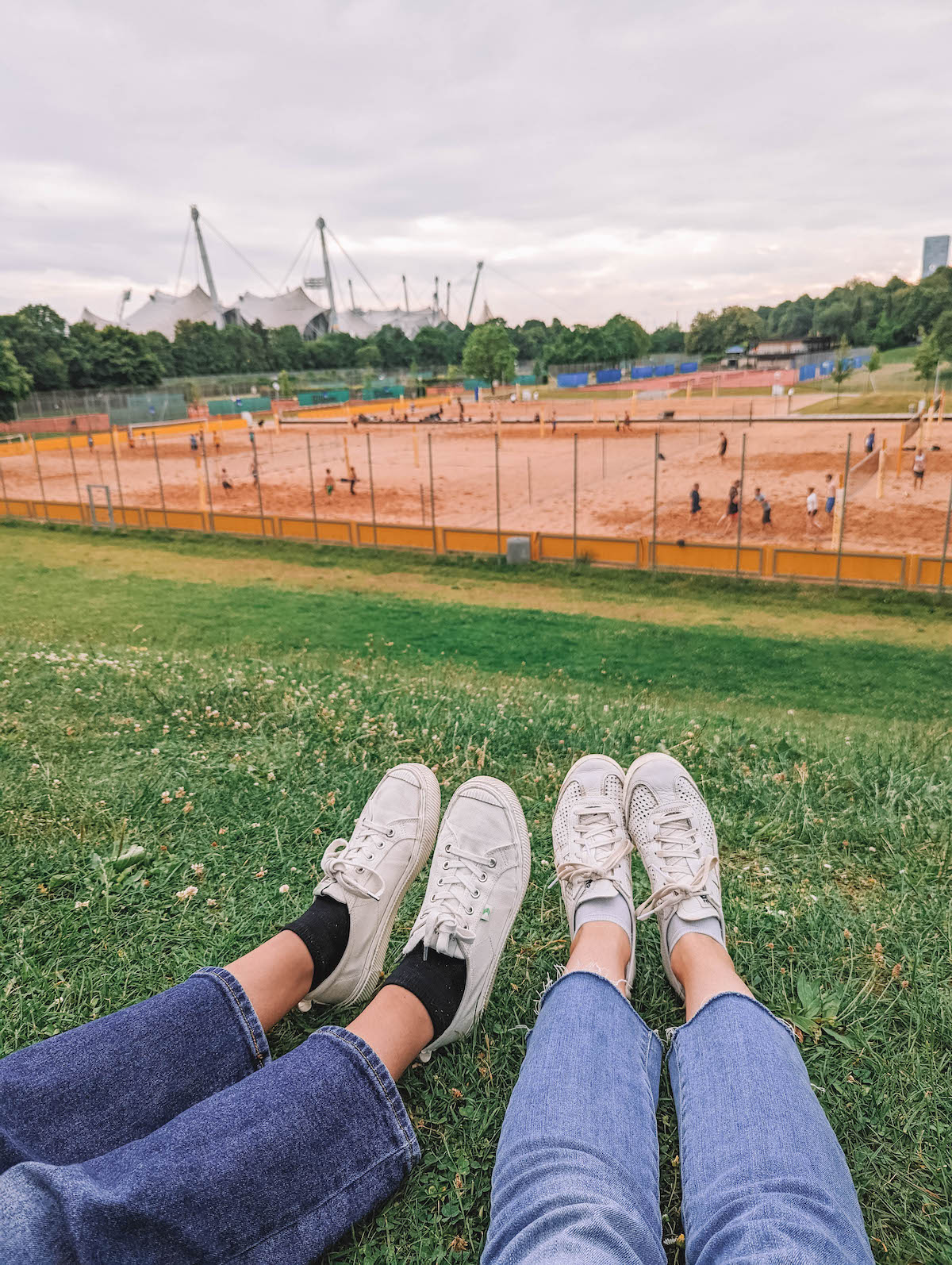
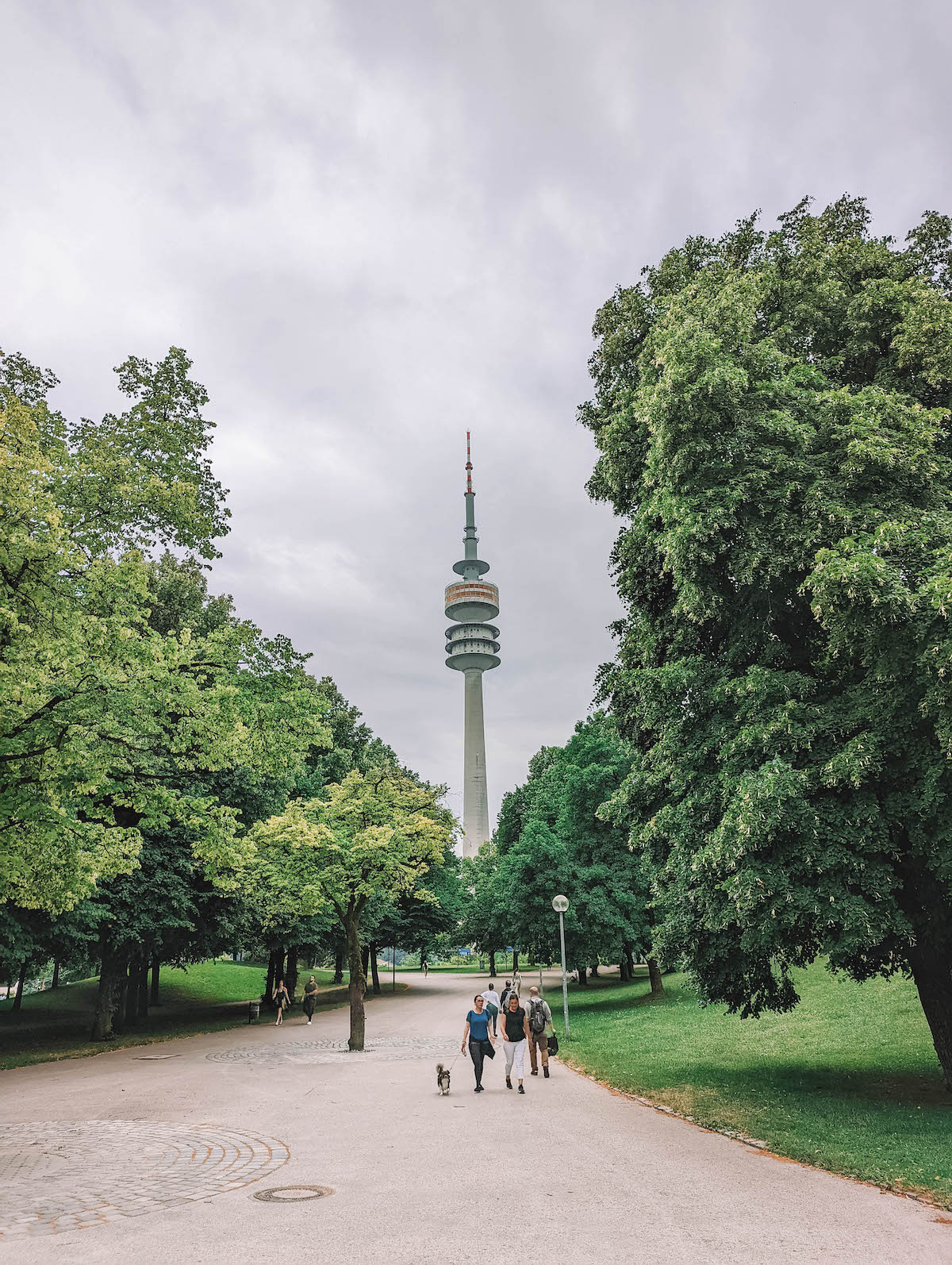
Yet another fun, free place to visit in Munich is Olympic Park. As the name suggests, the park was built for the 1972 summer olympics and continues to be a favorite gathering place and event location for locals.
In the middle of Olympic Park, there’s a 60-meter tall hill called the Olympiaberg (Olympic Hill). The hill was built from the rubble of the hundreds of buildings that were destroyed in the WWII air raids.
From the top of the Olympiaberg, you get a great view of the park, Munich, and — on a clear day — even the Alps! (Note that the photo above left is NOT the view, but it IS within the park. Turns out I forgot to take one last time I visited!)
Check Out the Newest Cars at BMW World
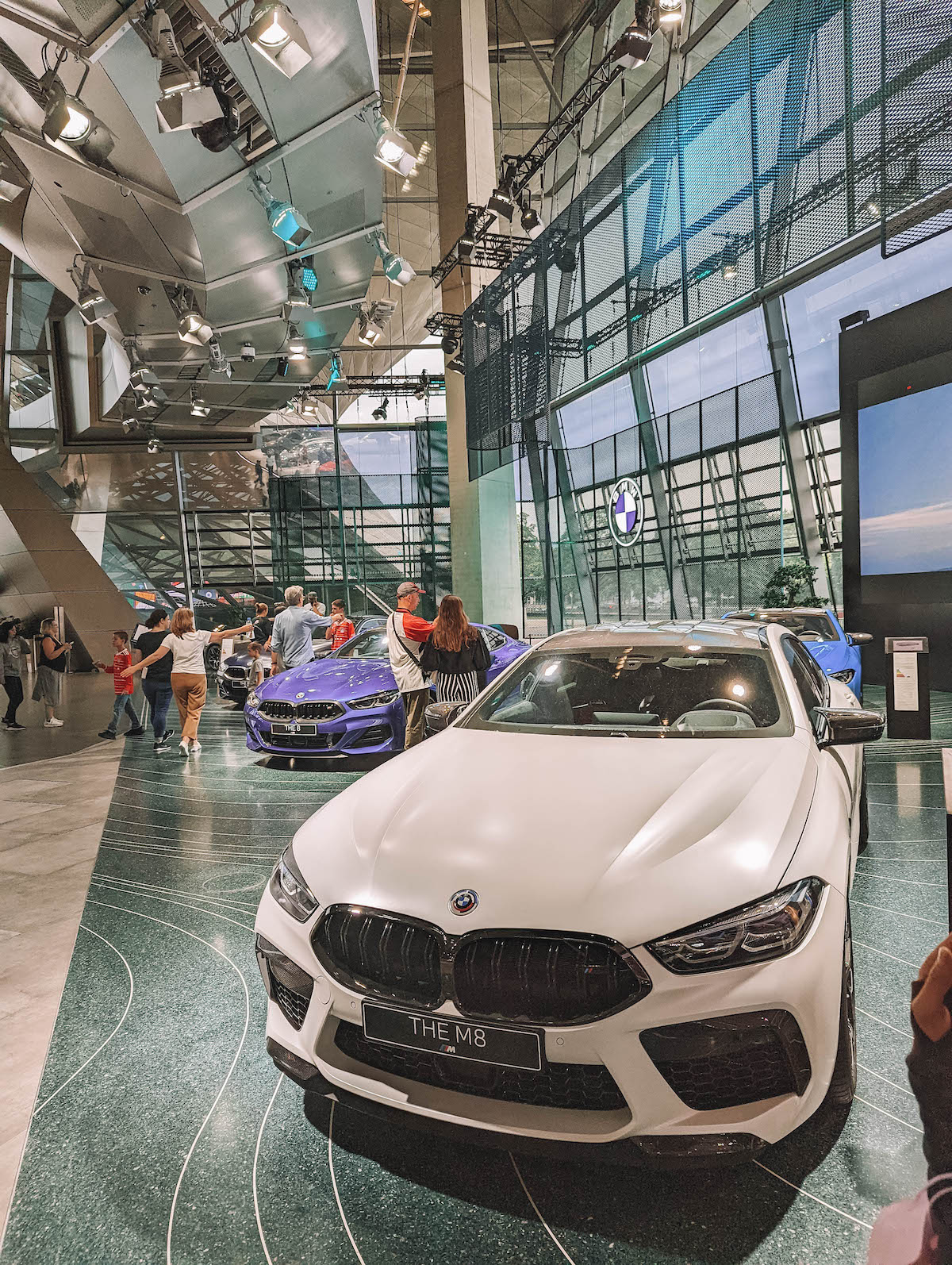
BMW (Bayerischen Motoren Werke) is headquartered in Munich, and in addition to the BMW Museum (which charges an admission fee) there’s a free exhibit near Olympic Park called BMW World.
This two-story space showcases the latest cars and motorcycles from BMW, MINI, and Rolls-Royce. You’re allowed to climb into most of the vehicles and take lots of cheesy “action” shots (which my friend and I most assuredly did!).
Relax in the English Garden
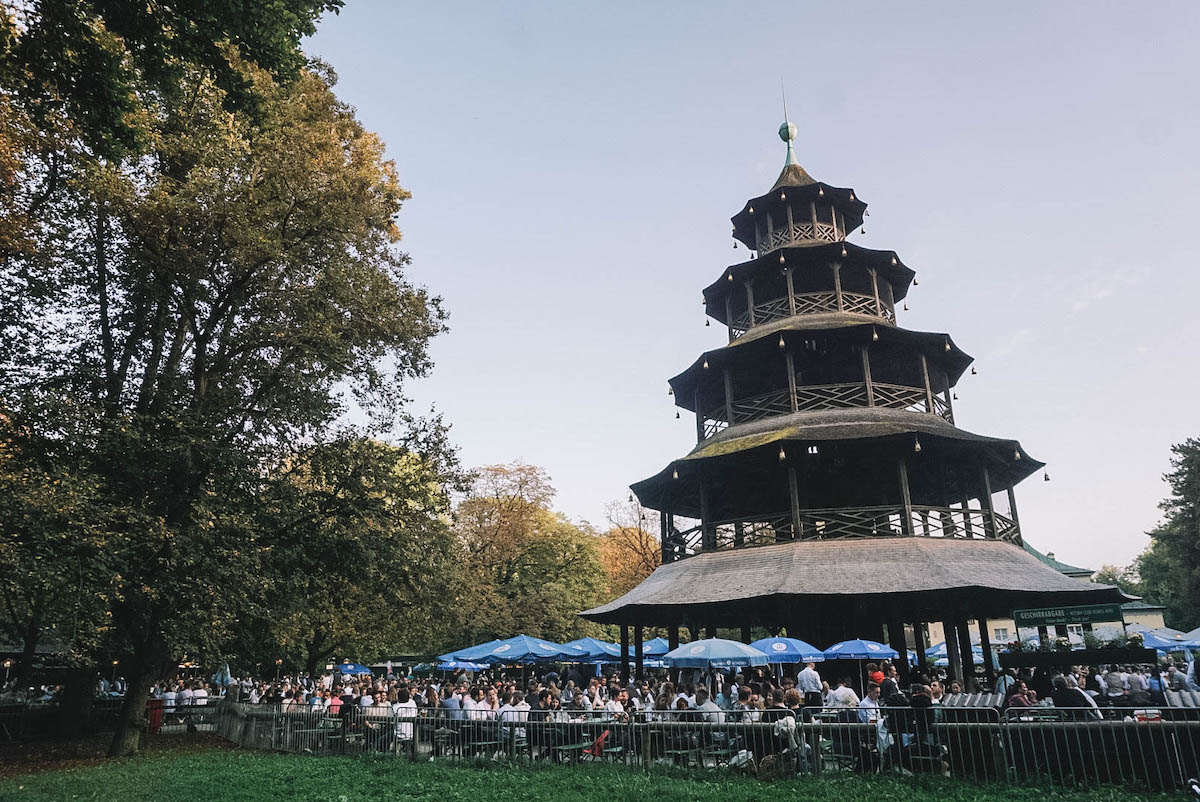
Munich’s largest public park, the English Garden is a wonderful free place to sit and read a book, rest your legs after a morning on your feet, or wander around to enjoy the scenery.
The garden is mostly open green space, with minimal landscaping. That doesn’t mean there are some hidden gems within the park, though!
Take time to track down the Chinese Tower (Chinescischer Turm), which was opened in 1790 and now is the home of Munich’s second-largest beer garden.
My other favorite spot in the English Garden is the Monopteros, a small temple structure perched on a hill in the middle of the park. There’s a great view of the park from the temple!
Watch the Eisbach Surfers
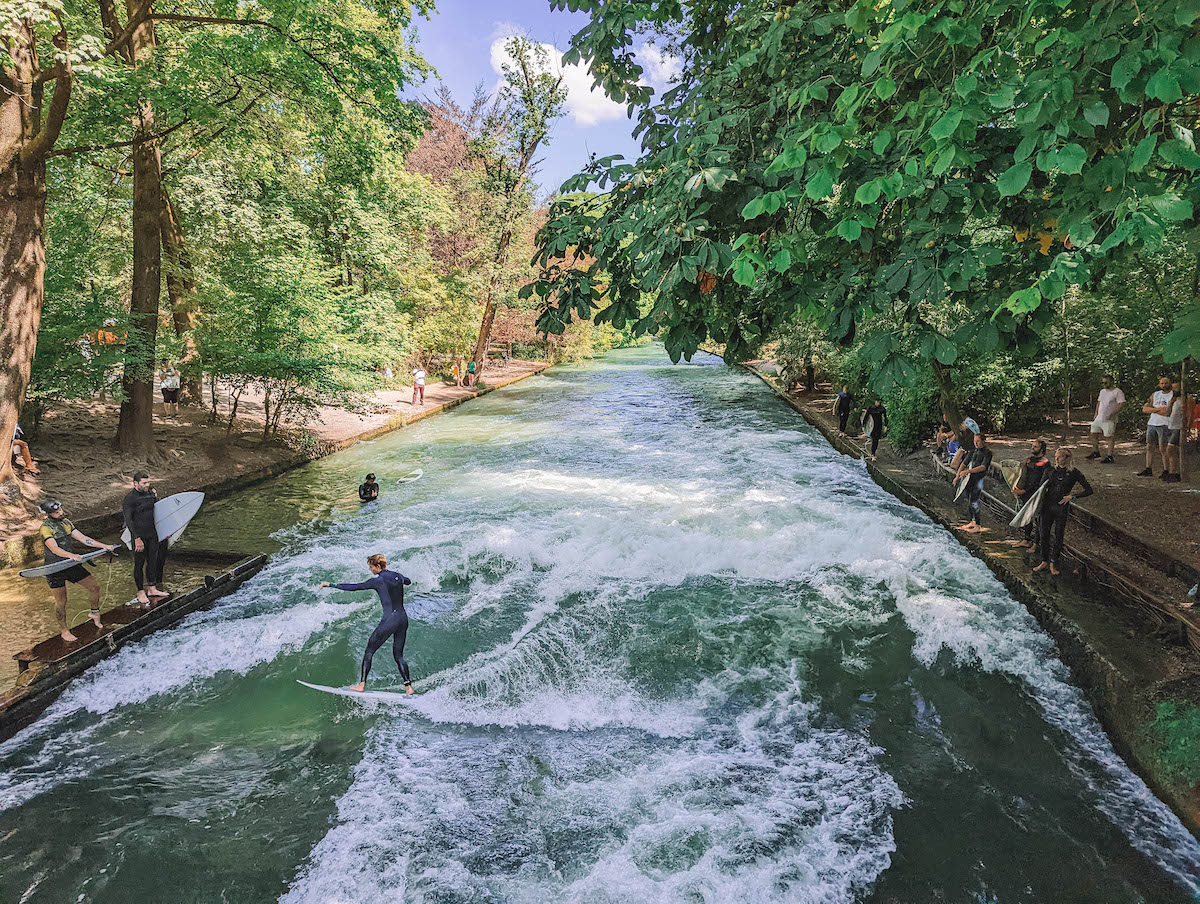
One of the star attractions in Munich that’s totally free to enjoy is the surfers at the Eisbach River. The Eisbach is a man-made river, with an artificial wave at one end where surfers don their wetsuits and hop on their surfboards.
For the best view of the surfers, stand along the Eisbach Bridge (Eisbachbrücke).
Explore the Gärtnerplatz Area

One of my favorite free things to do in Munich is simply explore new neighborhoods without a specific itinerary in mind.
On my last visit to Munich, I discovered the trendy Gärtnerplatz area. It’s within walking distance of the Old Town, but it’s just far enough away that not many tourists come to this part of the city.
Gärtnerplatz is a vibrant area with lots of local cafes and boutiques, all surrounding a pretty 19th-century roundabout with a fountain and garden in the center.
This area is especially known for its nightlife, but it’s fun to wander around during the daytime too!
Relax at Luitpold Park
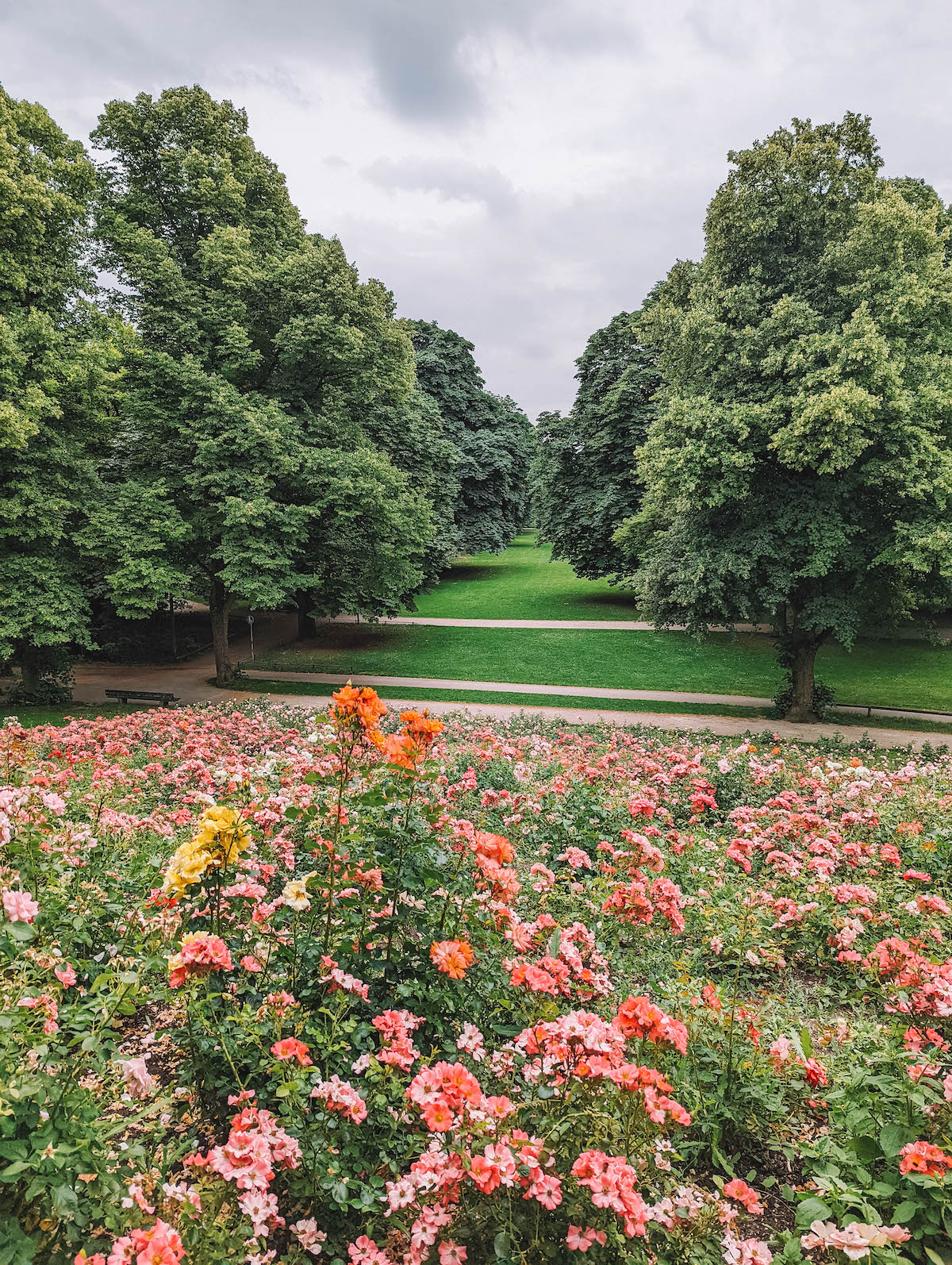
The English Garden (previously mentioned on this list) makes it onto most visitors’ Munich bucket lists, so Luitpold Park has remained a relatively undiscovered gem.
It’s a 33-acre park with lots of open green space, plus a beautiful array of roses in the very center of the park.
While you’re here, make sure to climb to the top of the Luitpoldhügel (Luitpold Hill), which is also known as the Schuttberg (rubble mountain). The hill is 37 meters tall and was built from the rubble left over from the air raids in WWII.
From the top of the hill, you’ll be treated to a view of the park and surrounding neighborhood.
Oogle the Antiques at Kunst Oase
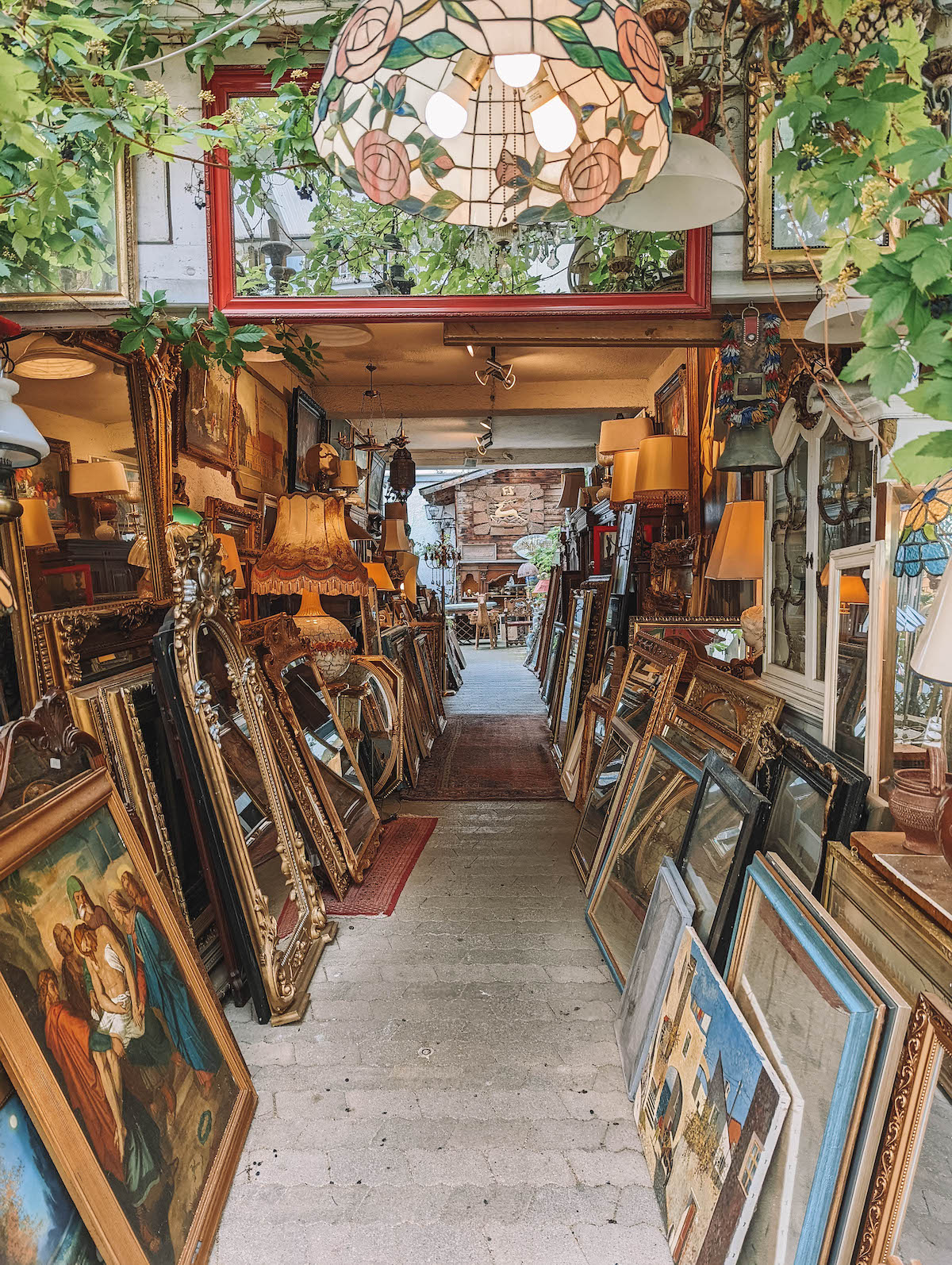
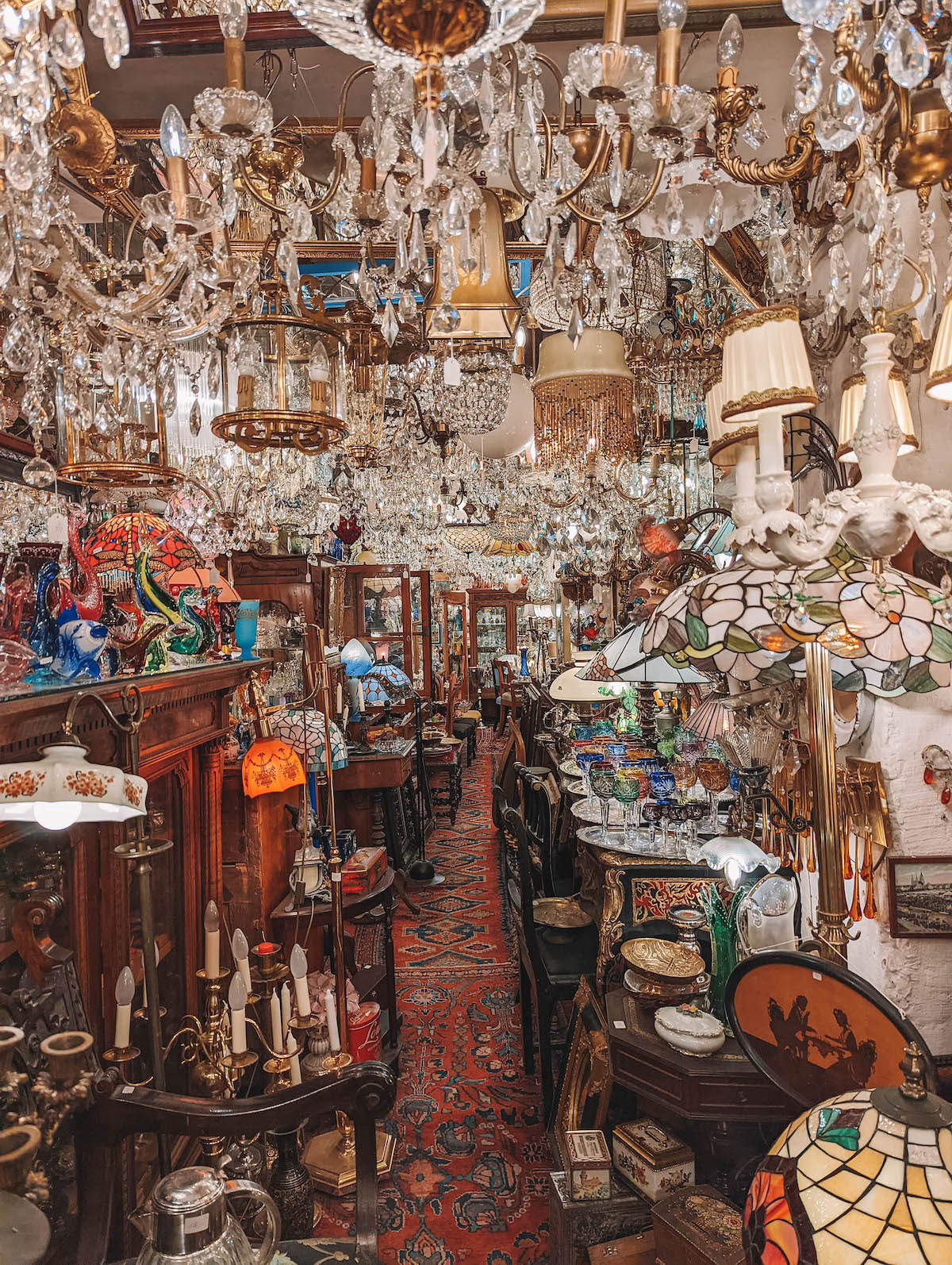
If you love antiques and shiny things, you have to visit the Kunst Oase (Art Oasis). It’s a real-life Aladdin’s cave that’s overflowing with antiques – porcelain, candlesticks, tableware, paintings, chandeliers, you name it!
You don’t have to buy anything at this antique store in the Schwabing neighborhood. It’s worth visiting just to see what’s in stock and immerse yourself in the treasures that are for sale.
Bonus: Visit Munich’s Christmas Markets!
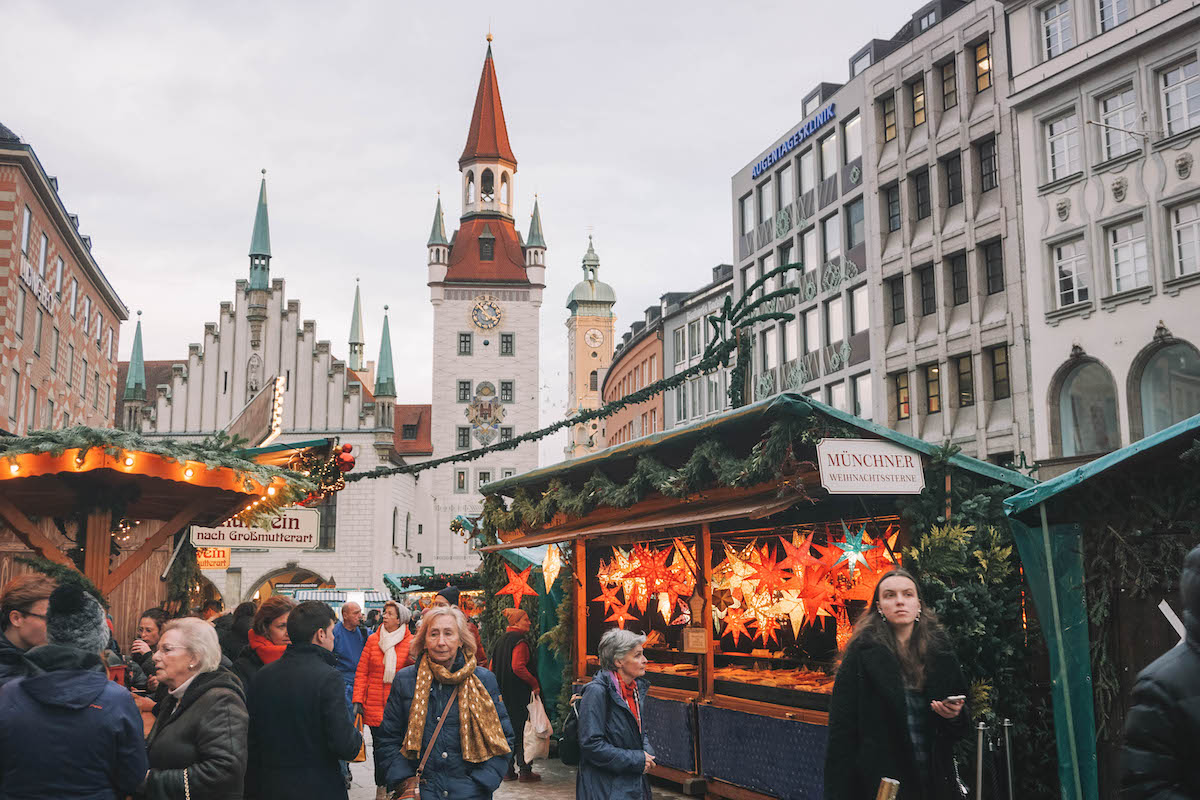
If you’re lucky enough to be in Munich in December, you definitely need to spend a day visiting the city’s many Christmas markets!
Around the holidays, the Old Town is overrun with stalls selling ornaments, beeswax candles, tasty nibbles, handmade gifts, and more. The main market at Marienplatz is my personal favorite, but a close runner up is the smaller medieval market at Wittelsbacher Platz.
You don’t have to pay to enter the Christmas markets, so feel free to wander around for free to soak up the festive ambience.
Tip: Most of the city’s Christmas markets run from the end of November through December 24th.
Is It Possible to Visit Munich on a Budget? Yes!
I hope this list of things to do and see in Munich for free inspires you to visit Bavaria’s capital city. Because, yes, it’s absolutely possible to plan your trip on a budget!
I’ve no doubt that there are many more wonderful free activities in the city, so if you have anything to add to this list don’t hesitate to leave me a comment below.
Don’t forget to follow me on Instagram to keep up with my daily adventures in Berlin and beyond!

Leave A Reply!